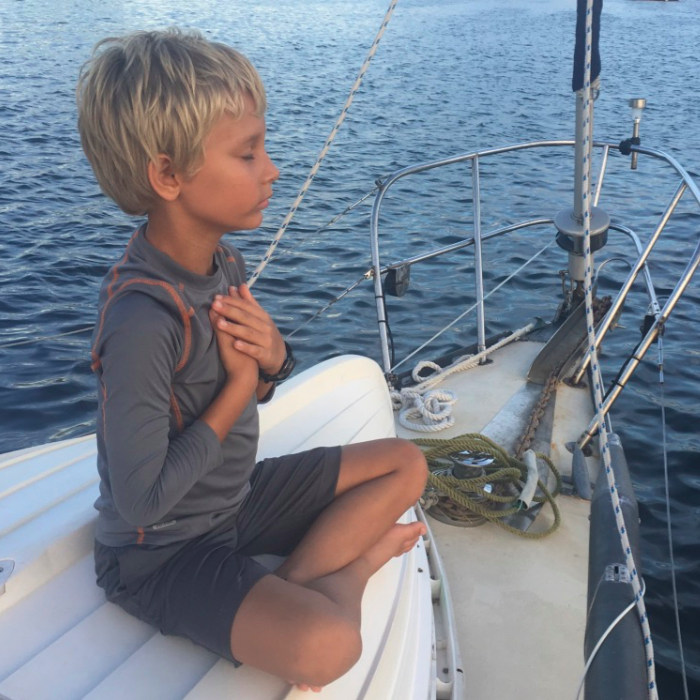What comes to mind when you hear the words mindfulness and meditation?
Peace? Serenity? Curiosity?
Or… complicated, impossible, and unhelpful?
If you relate more to the second thoughts, you are not alone. Those were my own beliefs for a long time.
But I’m going to introduce to you 14 low pressure mindfulness and meditation activities that don’t require subscriptions to religious factions, awkward chants, or pretzel positions.

First, let’s see what the difference is between the two.
The Differences Between Mindfulness and Meditation
Mindfulness involves focusing your attention on the environment around you or something particular in your surroundings. You might stare into a field, count your breaths, hone in on a sound, deeply savor a taste or smell, concentrate on something happening, or allow yourself to sink into a feeling, texture or temperature.
The main goal is to settle into the present so that you can better manage overpowering emotions as they arise.
Meditation involves releasing your mind from activity. It’s dropping or floating into silence and creating space for expansion and clarity.
The main goal is to train your mind to be centered more regularly.
Now, here’s why I think they are both worth trying:
Why Mindfulness and Meditation are Both Important
Mindfulness helps you stay calm and centered, regulate emotions, improve your focus, and hold memories. It helps you see what you might normally miss and connect to your environment in unique ways. It can help you with meditation.
Meditation helps you become open, light and grounded. It helps you become aware of your consciousness and thus more equipped to regulate your thoughts. It helps you improve concentration and mindfulness.
The combined benefits of mindfulness and meditation can help you relieve stress, anxiety and depression; gain self-insight and self-control; improve sleep; conquer unhealthy habits; and begin to visualize a different life you might be striving for. You could improve your physical health by possibly reducing your risk of heart disease, lowering your blood pressure, reducing chronic pain, alleviating digestive difficulties, and eating in a more healthy manner.
Note: You certainly don’t have to practice both mindfulness and meditation as they offer similar benefits. But I am going to offer strategies to easily include both into your daily lifestyle so you might produce a bigger boost of benefits, or at least experience both and discover if one benefits you more.
You might ask, how in the world am I supposed to fit in TWO more things into my busy days?
How to Fit In Both Mindfulness and Meditation Practices
First, disregard any thoughts that you have to devote lengthy spurts of time, include both every day, find or create the perfect setting.
Even a one minute pause can can bring immediate benefits and help you:
- quiet your mind and calm your body;
- handle an arousing situation with a bit of thought and intention and less reactivity;
- enter a likely stressful situation with an eased approach, calmed anticipation, and boosted energy and confidence.
That one minute can occur as needed, once daily, once before each meal, once before each difficult social encounter…. The more regularly you can make that magic moment happen the greater your results will magnify.
For now, I’ll just challenge you to make it happen once daily. Choose one low pressure activity from the lists and decide what time of day you can commit to trying it out for one full week.
Goal: just one activity from one list, for one minute, one time of day.
I started with one minute of practicing mindfulness first thing every morning. The ‘express gratitude’ activity was a good start for me because I was finding myself complaining a lot. As much as I was feeling dissatisfied with how I saw my circumstances, I was also feeling disappointed with myself for being so ‘begrudging’.
So, every morning—sometimes laying in bed, sometimes sitting on the deck watching a rising sun—I recalled three or four or 10 things for which I felt grateful. Big things like family, new clients, my health, our home on the water, safety. Little things like my husband’s homemade tacos for dinner, games with my son, new flippers, dark chocolate. Whatever…the little things are big things, too, aren’t they?
And guess what? It helped. I returned to my positive, hopeful, energetic self.
And guess what else? It was so easy to stick to…so easy in fact that I couldn’t help myself to stretch the time and extend my morning practice and add another mindfulness activity. And sometimes I even add in a minute or two of the ‘simple silence meditation’. I still only keep this morning practice to about five minutes, and it feels so, so good.
Plus, now when I find myself angry, flustered, irritated or depressed, instead of wanting to scream, run, or rip something up, I crave that relaxed feeling. I’ve become addicted to peace and want it so badly in my heart, life, home, surroundings, and for others.
Yes, I complete three mindfulness and meditation activities every morning for only about five minutes and I experience fantastic results.

So, how about some tools for your toolbox so you can start reaping the benefits, too?
14 Low Pressure Mindfulness and Meditation activities
Mindfulness:
Stare at someone you love. Notice expressions, movements, skin tone. Since my son was born I started putting this strategy into practice to firmly hold memories of him at different stages in his life. Every now and then I take a few seconds and study his maturing face, his growing body, his hair style, his mannerisms. I soak it all in for my mental scrapbook of his life.
Drink herbal tea. This is one of my favorite mindfulness activities because it engages all senses. You can become intoxicated by your favorite scents and flavors. You can be soothed by either warmth or coolness if you prefer it iced. The pretty shades of color serve as visual delights. Clinking sounds of a pot or kettle lid, a cup and saucer, or bobbing ice can lift your spirits. I find solace in the ritual of it all.
Express gratitude. Out loud, in your mind, or on paper. Bring to mind three things, events, people or experiences that you can be thankful for, that you are happy about, or that are just nice to have in your life.
Pray. If you believe in God, start talking to him. If you’re not sure how to start, use the previous ‘express gratitude’ activity and start with, “Dear, God”.
Journal. Think of this as an alternative to talking to yourself, an outlet to freely and fully express yourself without judgement or expectation, a commitment to pay attention to your life.
Write about happy events, express gratitude, describe lessons learned and wisdom gained. Or just write freely. No rules or parameters. Simply choose a time, such as first thing in the morning, and write.
I’m a dreamer and an analyzer, so for me writing has always been a tool for these, a physical ‘means’ to put my dreams to paper or hash out my decisions and the ‘hard things’. I always have thoughts and dreams running through my head and ideas and subjects to ponder. Do you?
Do you have a hard time making decisions, keeping track of ideas, holding lists in your head, shutting down dialogue in your mind? If so, this might be the perfect activity for you to try first.
Journaling is a powerful tool for bringing mindfulness to your life.
Eat Mindfully. Before you eat, slow yourself down, take a seat, inhale deeply, and prepare your body to accept nourishment. As you eat notice all that you experience: the sight, smell, sound, texture and taste of the food. Notice how your body responds to different foods.
Try eating with no phone, computer, or other distractions. Enjoy a quiet meal, soft music, or a pleasant conversation.
Adding variety could help as trying new foods will draw you to slow down and gain a sensory experience.
Enhance routine daily activities. A long, warm shower is a luxury as we fervently conserve water and have no water heater onboard. (Don’t worry! We do take regular showers!) When I can take a longer, warmer shower, I definitely indulge.
I’m not saying run your spout for a long length of time, no. I’m saying indulge in the time you do have under warm running water, or cool if you prefer. Close your eyes for a few seconds and focus on the sensations of the water pouring over your entire body, the spray on your head, the drips off your nose and elbows, the flow down your belly, the splash on your feet. I love these sensations.
While washing the dishes, take a few seconds to fold and massage your hands under the running water.
Caress the sheets, blankets and comforters as you pull them up on your bed and tuck them tight.
Notice differences on the streets of your regular commute; or focus on the newness of a different route.
Deeply inhale aromas as you prepare a meal.
Hum away negative thoughts as you perform regular duties and chores at work or home. Don’t worry…I do this ALL THE TIME, and my family doesn’t ever seem annoyed.
Mindful partnership. This is great if you just can’t get any time alone. Draw your children into a moment of pause to watch something happening in nature; track bubbles rising until completely out of sight; view clouds rearranging into puppies, bears, and dolphins; compare songs of birds that visit your backyard; trace circles in sand, snow, dirt, or a puddle of water.
With a spouse or someone you take care of (which might be both), share a song, a poem, art, a view…bonus points if you do it leaning shoulder to shoulder, or holding hands.
Mindfulness YouTube or App recordings. You can explore these and find some with or without music, visualizations, or chants to follow. Different voices might be more calming than others. Sometimes a little more guidance helps. See what resonates for you.
Meditation:
Simple sitting meditation. Sit anywhere—in bed, on your couch, at a table with a cup of coffee between your hands, at your desk, outside a waiting room, in your car, on your porch… and just close your eyes and take a deep breath. Set no expectations. None.
You can think of a word like silence, steady, or peace. Or just concentrate on your breathing, counting if you want. My favorite breathing pattern is inhaling deep for a count of four, holding four, then exhaling eight. It’s not about seconds. Count at a speed that is comfortable for you. My 4-4-8 pattern is pretty slow.
You can also let yourself focus on a constant sound. Just keep your eyes closed so your mind can settle as it wants, not on a visual cue.
If you’re struggling with a decision, this form of meditation can serve you if you first ask your question, speaking to God, the universe, your higher power, whatever you believe gives you strength. Ask your question with your hands on your heart; move one hand to your stomach if you are usually sensitive to gut feelings and intuition.

Walking meditation. No pressure to get a workout, or even go very far. If you can get outdoors, even on a lunch break downtown, great. If you can only pace a hallway, that’s okay, too. But keep it slow and steady. Match your steps to slow deep breaths, following the same breathing pattern I described before if you like. Close your eyes if you’re familiar with the space; gaze forward and slightly down at the path in front of you if necessary; or gaze upwards, opening yourself to hope and inspiration as you walk.
Again, stay silent and concentrate on a breathing pattern or one word, thought or positive feeling you desire. You can include any variation of ‘simple sitting mediation’, besides sitting, obviously.
Mantra meditation: You might consider choosing a word or phrase to focus on for a day, a year, or a lifetime. My word of the year for 2020 is ‘authentic’. I started this blog before the new year started, and I wanted a word to guide me and keep me grounded and focused in life and work.
I also focus on the word ‘peace’. It is both a daily request and a feeling I relish in.
Think of a word or phrase you can either use as your anchor for your wandering mind or wavering heart, or as a guide for your utmost dreams.
Some more examples: calm, love, courage, bravery, open mind, open heart, confidence, light, ease, easy-going, fun, joy, worry-free, judgement-free.
You could choose a needed phrase or affirmation such as: May I be light in mind, body, heart and spirit (my favorite); I am fulfilling my dreams; I am strong and confident; I am worthy of love.
Visualization meditation. With eyes closed, imagine clouds drifting past, a waterfall cascading, or a wooden raft floating down a river carrying away your negative thoughts, worries, and judgements.
What is your idea of paradise? Create a mental scene for a brief escape.
Mental images serve as powerful tools to ease the mind and carry it to a more stable place. Depression, anxiety and stress can not squeeze past the vision of a sunset over a Rocky Mountain horizon or a serene seashore covered with seabirds dancing in rippling, foamy water.

Breath awareness. I explained my favorite breathing pattern in the ‘simple sitting meditation’ description above. But you don’t even have to get that technical. What’s most important is your breathing technique.
You want to make sure your abdomen, located just under your rib cage, is expanding and contracting, not your lower belly, and not your shoulders raising and lowering. Along with this focus you will feel your belly and rib cage protrude slightly, but concentrate on that abdomen area. You want your lower belly staying slightly tight supporting you, not stretching out; and you want your shoulders relaxed, not tensing up.
Just take slow deep breaths in and out and concentrate on that abdominal area working like it should.
Most importantly regulate and use your breath as another anchor for a mind raging with storms, a gut fluttering with anxiety, or a heart welling with sadness.
In Conclusion:
As you partake in any one of these mindfulness or meditation exercises so much more might arise for you. How many times has a great idea popped into your head in the shower?
While you’re staring at and admiring a mosaic horizon you may be flooded by forgiveness for someone who hurt you long ago and decide it’s time to let it go. Your purpose in life may become evident to you as you walk through a stained glass forest. Sitting in silence, taking deep breaths to ease your anticipation of a stressful office meeting might also bring to mind the title of that book your coworker keeps asking you about.
Also, your mind might drift off course. If so, offer yourself compassion and try to bring it back to your chosen activity and experience. Or give it another moment’s chance later or tomorrow. Don’t recite a mantra to “focus, focus, focus.” Just try different techniques from the list until you find one that you can stick with and notice results after one full week.
What are you going to try this week? What mindfulness or meditation activity have you already found helpful? I’d love to know in the comments.
You might also like to read:
“Setting Anchor: A Method to Manage Reactivity and Mindset in the Midst of Chaos and Uncertainty”

Hi! I’m Jennifer, your life, love and wellness coach! I help men, women and couples figure out what’s keeping them from being happy and healthy so they can overcome those blocks and determine and implement steps to truly improve their lives, relationships, and physical and mental health. I’m a certified Professional Life Coach and Holistic Health Coach with a background in professional counseling. I’m ready to help you. jennifer@starkwellness.com
[…] in calming down your central nervous system. I wrote about one of my favorite breathing techniques HERE. It’s a super simple and effective 4-4-8 breath […]